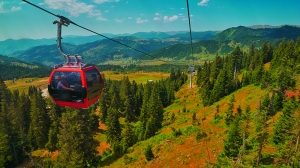Georgia has historically been at the edge of empires. This has been both an asset and a hindrance to the development of the country. An asset because Georgia’s difficult geography and a distant location from global centres prevented major powers from invading and keeping the country permanently under their rule. Hindrance because Georgia’s geography requires major investments to override its mountains, gorges and rivers.
This geographic paradigm has been well in play in shaping Georgia’s geopolitical position since the breakup of the Soviet Union in 1991. Ever since, Georgia has been playing a rebalancing game through turning to other regional powers to counter the resurgent Russia. Turkey, Azerbaijan, Iran – partly – and bigger players such as the EU and the US are those which have their own share of interest in the south Caucasus. However, over the past several years yet another power – China with its still evolving Belt and Road Initiative (BRI) – has been slowly emerging in the South Caucasus.
But despite the fact that China is rapidly increasing its economic presence in Georgia, which ultimately could turn into larger Chinese security involvement, Beijing’s investment and interests in the region still lag behind what China has been doing in Central Asia, Pakistan or other regions upon which the BRI initiative has an impact. Another interesting aspect is Georgia’s balancing act, whereby Tbilisi wants to use growing Chinese influence to further balance Moscow’s military power. However, here too not everything is that clear-cut, as Moscow and Beijing could also cooperate in the south Caucasus as they currently do in other regions, for example in Central Asia.
China has close trade contacts with all the south Caucasus countries and has invested extensively in the region. Among those relationships the Georgian-Chinese cooperation does indeed stand out but is not a particularly recent phenomenon. After the collapse of the Soviet Union, Chinese immigrants to Georgia were driven by Chinese state-owned investment activities in the region. In the early 2000s, the majority of the migrants were involved in corner shop and market vendors’ businesses, as well as restaurants, whereas after 2010, construction workers accounted for the most Chinese migrants.
For Georgia, China is now its third-largest trade partner (the first two places are held by Turkey and Azerbaijan; Russia is fourth). Trade between the two countries has significantly increased over the past 10 years. If in 2002 bilateral trade was a mere 10 million US dollars, in 2014-2015 it reached 823 million US dollars. Moreover, in 2017 China and Georgia finally signed a free trade agreement. The country also hopes that its position at the Black Sea with several ports such as Batumi, Poti and Anaklia will make it a logistics hub for the entire region and particularly for China’s BRI initiative.
Within the BRI context
China only recently set its eye on the transit potential of the South Caucasus and its valuable infrastructure. This interest is largely conditioned by China’s BRI initiative, which is a multi-billion-dollar project, according to which the country’s east will be reconnected (as in ancient times) to Europe via the shortest distance, be it through southern Russian, Central Asia, or the South Caucasus and the Black Sea (although that is not the only corridor the Chinese are working on).
Georgia can boast Black Sea ports, an east-west highway which essentially connects Azerbaijan and the Black Sea coast and existing and upcoming railway projects (Baku-Tbilisi-Kars). Indeed, from the Chinese perspective the two most valuable projects Beijing is eyeing in the South Caucasus are related to Georgia: 1) The upcoming opening of the Baku-Tbilisi-Kars railroad which will allow 45 per cent faster delivery of containers, freight and passengers from Asia to Europe; 2) Expanding the East-West Highway, Georgia’s main land road, in cooperation with the World Bank, the Asian Development Bank, and other organisations.
China has been testing the South Caucasus route since the announcement of the Belt and Road Initiative in 2013. For example, in 2015 the efficacy of the connection between Xinjiang province in China to the port of Poti in Georgia, via Kazakhstan and Azerbaijan was tested. Railway cargo loaded in China on January 29 arrived in Georgia on February 6 of the same year. However, almost a third of the time in transit was spent handling administrative obstacles. Several other tests too were carried out to prove the possibility of the trade and transit route through the South Caucasus.
However, despite the advantages Georgia has as a transit country there are still numerous questions. It could be said that overall China still remains ambivalent about the Caucasian stretch of the Silk Road. It is true that Beijing is interested in the strategic relevance of the region, but it nevertheless recognises that commercial engagement remains tentative. The South Caucasus route still remains out of major transit and trade routes China is heavily investing in.
Analysts do forget that the South Caucasus route does not feature much in the following corridors anticipated under the BRI initiative — China to Europe through a New Eurasian Land Bridge; the China-Mongolia-Russian Corridor and the Central and West Asian countries.
The 21st Century Maritime Silk Road mainly relies on Chinese coastal ports: the China-Indochina Peninsula Corridor and China’s links with the South Pacific Ocean through the South China Sea; China-Pakistan trade corridor and the Bangladesh-China-India-Myanmar trade route.
Compared to major Chinese-financed infrastructure and energy works completed in Russia, Kazakhstan, and Uzbekistan over the past two years, state-owned Chinese companies have yet to secure any similar scale projects in the Caucasus region. Indeed, the Chinese are building major road and railway infrastructure in Uzbekistan and are extensively investing in Kazakhstan and Kyrgyzstan. In Georgia, for the moment, Beijing is largely interested in existing and upcoming infrastructure and is investing into construction in Tbilisi, Kutaisi and other major cities.
Possible wider geopolitical ramifications for Georgia
Tbilisi sees intensive relations with China as yet another tool to somehow diminish Russian resurgence. With its pro-Western course maintained the country dearly needs Chinese investment as it will foster the creation of jobs and other economic opportunities. So far the Chinese have built a new city on the outskirts of Tbilisi, have invested in Kutaisi – the second-largest city in the country, and own three quarters of the shares in Poti’s Free Industrial Zone. Although it is difficult to see the importance of investments in Tbilisi and Kutaisi, investment in Poti is significant. An ordinary observer could see a clear east-west line to the Black Sea dotted with Chinese presence all along the route. Surely it is for the moment difficult to ascertain what Chinese moves will be in the future, but it is also clear that as Russian forces move the demarcation line of the breakaway South Ossetia to the south, closer to the east-west highway, China will be more worried as it endangers its economic interconnection with Europe. Beijing will either have to find a consensus with Russia or get more involved security-wise. And there is already a precedent for China getting involved militarily in the territories important to its BRI project. For example, in Central Asia China has made some steps which potentially could challenge Russia’s economic and political influence in the region. We know that China is already the largest trade partner of each of the Central Asian states and that Beijing has deepened its military and security ties with Tajikistan and partly with Kyrgyzstan mainly by holding military exercises and building military infrastructure on the Tajik-Afghan border.
For Tbilisi it will be a boon to its security if China is more involved in the South Caucasus. However, for the moment it might only be wishful thinking that China will openly confront Russia anytime soon. Even in Central Asia, despite inroads, Moscow still does not openly say that Beijing is compromising the existing order.
Another reason to think that Georgia will not so easily become a place of confrontation between China and Russia is the fact that the country is only a small piece in China’s BRI. Also, although Beijing will pay more attention to the region it may not actively invest resources into Georgian security beyond law enforcement and counterterrorism cooperations, as in Tajikistan and Kyrgyzstan. This would be the case especially if its actions would clash with Russia’s. There are several other transit routes in China’s grand BRI project.
As such the situation for the moment could be characterised as mixed. Beijing is definitely increasing its economic influence in Georgia. However, the level of investment is below that of Chinese investment in Central Asia or Pakistan. Beijing is more interested in existing and upcoming infrastructure, while its relations with Russia are unlikely to be compromised if Russia does not threaten the major East-West highway.







Add Comment